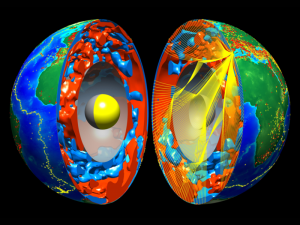
A team of researchers recently discovered an ancient relic hidden within Earth: a tectonic plate resting beneath the southern Indian Ocean. Scientists have found other tectonic plates that sank below Eurasia and North America, but here Simmons et al. describe the unique structure of this newly discovered slab, which they named the Southeast Indian Slab (SEIS).
The slab has at least one feature scientists have rarely seen before: It maintains its slab-like structure all the way from the upper mantle near Earth’s crust down to the region where the mantle meets the planet’s superheated core. The Farallon plate beneath North America is a well-known example of this—but it was expected to exist and sank much more recently than the SEIS. In addition, not only does the SEIS traverse the entire mantle, but it also becomes more vertical along one end, so much so that it stands almost vertically between the crust and core along the eastern edge, whereas the western portion is more horizontal.
Researchers can make out structures beneath Earth’s crust by examining the speed at which seismic waves generated by earthquakes and similar Earth-shattering events—known as P and S waves—travel through Earth. Here the researchers used wave data from 12,607 seismic events dating back to the 1960s, collected by 7783 seismic stations around the world, to develop the model that identified the ancient slab.
Once this tectonic slab was identified, the team looked at the region’s tectonic history over millions of years to determine where and when this plate was on the surface. They determined that the slab was once along the eastern portion of the early supercontinent of Gondwana. Then, sometime during the Triassic or Jurassic period, which stretched from 250 million years ago to 145 million years ago, the slab plunged underneath another plate. They further concluded that the subduction, or the sinking of the Southeast Indian Slab beneath another plate, terminated around 130 to 140 million years ago in the Mesozoic era, around the same time that the tectonic plates under eastern Gondwana began to separate and split up the continent.
Tectonic plates usually sink down into the mantle at a rate of about 1 centimeter per year or more; they don’t necessarily melt but instead bunch up at the base of the mantle and eventually assimilate or become undetectable as their temperature increases. However, if the researchers accurately estimated the timing of their newly discovered slab’s subduction, this slab must have stalled in a transition zone before descending deeper down into the mantle, allowing the slab to persist in the mantle longer than any other known plate.
Reference:
N. A. Simmons, S. C. Myers, G. Johannesson, E. Matzel, S. P. Grand. Evidence for long-lived subduction of an ancient tectonic plate beneath the southern Indian Ocean. DOI:10.1002/2015GL066237
Note: The above post is reprinted from materials provided by Eos-American Geophysical Union. The original article was written by Cody Sullivan.










